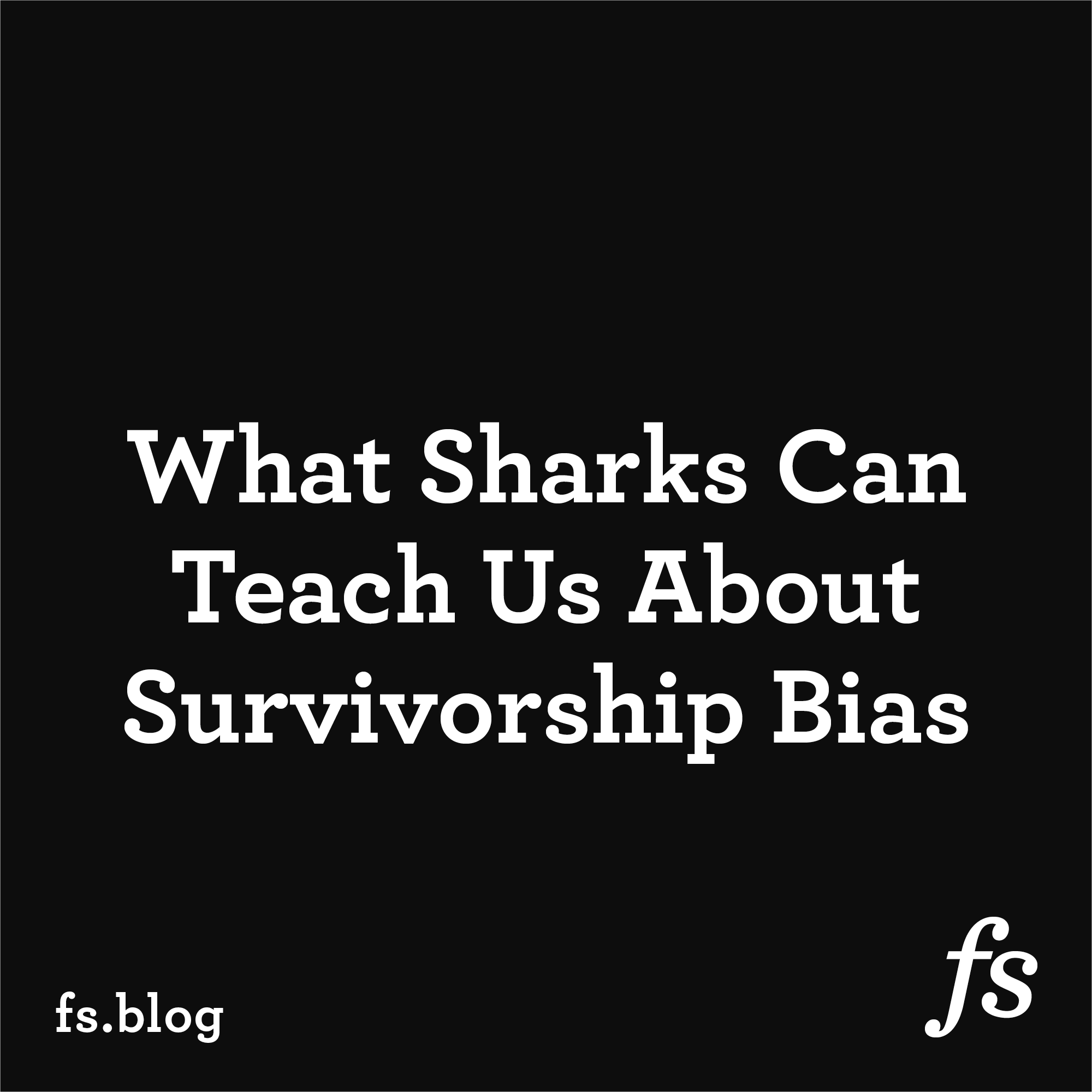When You Live to Tell the Tale
We can’t completely overcome survivorship bias. The best we can do is acknowledge it, and when the stakes are high or the result important, stop and look for the stories of those who were unsuccessful. They have just as much, if not more, to teach us.

Capital Thinking • Issue #705 • View online
When asked what the deadliest shark is to humans, most people will say the great white.
The lasting influence of the movie Jaws, reinforced by dozens of pop culture references and news reports, keeps that species of shark at the top of the mind when one considers the world’s most fearsome predators.
While it is true that great white sharks do attack humans (rarely), they also leave a lot of survivors.
And they’re not after humans in particular. They usually just mistake us for seals, one of their key food sources.
What Sharks Can Teach Us About Survivorship Bias
Shane Parrish | Farnam Street:
We must be careful to not let a volume of survivors in one area blind us to the stories of a small number of survivors elsewhere.
Most importantly, we need to ask ourselves what stories are not being told because no one is around to tell them.
The experiences of the dead are necessary if we want an accurate understanding of the world.
***
Before we drill down into some interesting statistics, it’s important to understand that great whites are one member of a class of sharks with many common characteristics.
Great whites are closely related to tiger and bull sharks. They all have similar habitats, physiology, and instincts.
They are also all large, with an average size over ten feet long.
Tiger and bull sharks rarely attack humans, and to someone being bit by one of these huge creatures, there isn’t all that much difference between them.
The Florida Museum’s International Shark Attack file explains that “positive identification of attacking sharks is very difficult since victims rarely make adequate observations of the attacker during the ‘heat’ of the interaction. Tooth remains are seldom found in wounds and diagnostic characters for many requiem sharks [of which the great white is one] are difficult to discern even by trained professionals.”
The fatality rate in known attacks is 21.5% for the bull shark, 16% for the great white, and 26% for the tiger shark.
But in sheer volume, attacks attributed to great whites outnumber the other two species three to one. So there are three times as many survivors to tell the story of their great white attack.
***
When it comes to our picture of reality of the most dangerous shark, there are other blind spots.
Not all sharks have the same behaviors as those three, such as swimming close to shore and being around enough prey to develop a preference for fat seals versus bony humans.
Pelagic sharks live in the water desert that is the open ocean and have to eat pretty much whatever they can find. The oceanic white tip is a pelagic shark that is probably far more dangerous to humans—we just don’t come into contact with them as often.
There are only fifteen documented attacks by an oceanic white tip, with three of those being fatal. But since most attacks occur in the open ocean in more isolated situations (e.g., a couple of people on a boat versus five hundred people swimming at a beach), we really have no idea how dangerous oceanic white tips are.
There could be hundreds of undocumented attacks that left behind no survivors to tell the tale.
One famous survivor story gives us a glimpse of how dangerous oceanic white tips might be.
In 1945, a Japanese submarine shot down the USS Indianapolis. For a multitude of reasons, partly due to the fact that the Indianapolis was on a top secret mission and partly due to tragic incompetence, a rescue ship was not sent for four days.
Those who survived the ship’s sinking had to then try to survive in the open ocean with little gear until rescue arrived. The water was full of sharks.
In Indianapolis: The True Story of the Worst Sea Disaster in US Naval History and the Fifty-Year Fight to Exonerate an Innocent Man, Lynn Vincent and Sara Vladic quote Boatswain’s Mate Second Class Eugene Morgan as he described part of his experience:
“All the time, the sharks never let up. We had a cargo net that had Styrofoam things attached to keep it afloat. There were about fifteen sailors on this, and suddenly, ten sharks hit it and there was nothing left. This went on and on.”
These sharks are believed to have been oceanic white tips.
It’s unknown how many men died from shark attacks. Many also perished due to exposure, dehydration, injury, and exhaustion.
Of the 1,195 crewmen originally aboard the ship, only 316 survived. It represents the single biggest loss of life from a single ship in US naval history.
Because humans are rarely in the open ocean in large numbers, not only are attacks by this shark less common, there are also fewer survivor stories. The story of the USS Indianapolis is a rare, brutal case that provides a unique picture.
***
Our estimation of the shark that could do us the most harm is often formed by survivorship bias.
We develop an inaccurate picture based on the stories of those who live to tell the tale of their shark attack.
We don’t ask ourselves who didn’t survive, and so we miss out on the information we need to build an accurate picture of reality.
***
Survivorship bias crops up all over our lives and impedes us from accurately assessing danger.
Replace “dangerous sharks” with “dangerous cities” or “dangerous vacation spots” and you can easily see how your picture of a certain location might be skewed based on the experiences of survivors.
We can’t be afraid of a tale if no one lives to tell it.
More survivors can make something seem more dangerous rather than less dangerous because the volume of stories makes them more memorable.

*Featured post photo by Dan Seddon on Unsplash
